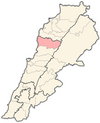to jido

Byblos Castle is a Crusader castle in Byblos, Lebanon. In Crusader times it was known as the Castle of Gibelet /ˈdʒɪbəlɪt, ˈdʒɪblɪt/, also spelled Giblet, which belonged to the Genoese Embriaco family, Lords of the city.[1][2] It is adjacent to the Phoenician archaeological site containing the ruins of the Temple of Baalat Gebal and the Temple of the Obelisks.
YouTube Encyclopedic
-
1/3Views:6841 060513
-
Byblos Castle Lebanon Second Oldest City in the World
-
LEBANON ESCAPADE: BYBLOS LEBANON| BYBLOS CASTLE| Marz Nassar
-
Places To Visit In Lebanon: Byblos Castle
Transcription
History

The castle was built by the Crusaders in the 12th century from indigenous limestone and the remains of Roman structures. The finished structure was surrounded by a moat. It belonged to the Genoese Embriaco family, whose members were the Lords of Gibelet from 1100 to the late 13th century. Saladin captured the town and castle in 1188 and partially dismantled the walls in 1190. Later, the Crusaders recaptured Byblos and rebuilt the fortifications of the castle in 1197. In 1369, the castle had to fend off an attack from Cypriot vessels from Famagusta.[3]
The Byblos Castle has distinguished historical buildings for neighbors. Nearby stand a few Egyptian temples, the Phoenician royal necropolis and the Roman amphitheatre.[3]
Description
The Crusader castle of Gibelet is "the finest example" (Boas) of a new 12th-century type, which mixes the castrum-type with the turris-type castle:[4] a roughly square set of walls strengthened by corner towers, built around a central donjon,[5] thus forming two layers of defense.
Byblos Site Museum


The castle houses the Byblos site museum. It displays remains of the excavations undertaken on the site of the archeological preserve of Byblos, although the most important finds are displayed in the National Museum of Beirut. Moreover, the history of Byblos from prehistory to the medieval periods, is illustrated with thematic panels.[6]
See also
Further reading
- Thiollet, Jean-Pierre (2005). Je m'appelle Byblos (in French). Paris: H & D. ISBN 9782914266048.
References
- ^ G. Massiot & cie. "Crusader Castle, Byblos: Overall view, castle and surrounding groves". Architectural Lantern Slides of Lebanon. Hesburgh Libraries, University of Notre Dame, Indiana. Retrieved 15 December 2017.
Byblos... Under the name of Gibelet or Giblet...
- ^ "Byblos Citadel – LebanonUntravelled.com". Retrieved 2021-09-30.
- ^ a b "Byblos Castle". Retrieved 2 March 2013.
- ^ Adrian Boas (2006). Archaeology of the Military Orders: A Survey of the Urban Centres, Rural Settlements and Castles of the Military Orders in the Latin East (c.1120-1291). Routledge. ISBN 9781134422838. Retrieved 15 December 2017.
- ^ David Nicolle, Crusader Castles in the Holy Land 1097-1192, Osprey, 2004, pp. 11-12 Archived 2018-04-21 at the Wayback Machine
- ^ "The Byblos Site Museum". Archived from the original on 2018-02-01. Retrieved 2018-01-31.
External links
- "Byblos info".
- "Byblos at MiddleEast.com".
- Michael J. Fuller. "Crusader Era Sites - Middle East: Giblet/Byblos/ Jebail". St. Louis Community College.
1987-2011: chronology, plans, photos, GPS data
- Maxime Goepp. "Gibelet" (in French).
recent photos, history, description
34°07′12″N 35°38′47″E / 34.12°N 35.6464°E


